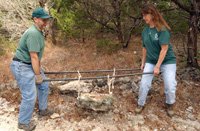"Trail Taming Techniques" classes recognized by Austin American-Statesman
Saturday, December 10, 2005
"BLAZING THE TRAIL FOR BEGINNERS"
Group that builds, maintains trails in parks also trains home gardeners to create paths through their landscapes.
Winter is a great time to ponder building a path in the Central Texas landscape. The pondering part is important, especially in an erosion-prone region where a gullywasher can quickly obliterate a poorly planned trail you've worked so hard to build.
Enter Central Texas Trail Tamers, a group that has built and/or maintained trails in state parks and other public places in Texas, Wyoming, California and Mexico. The organization now offers lectures and hands-on workshops for those who would like to move past the pondering process, but aren't sure how.
"This trail-building stuff is not rocket science; it's just sort of a lost art," says trail tamer Dave DeGroot. "To be sustainable, you need to think quite a bit before you start digging up the earth."
True, you might not need that much expertise if your plan involves laying stepping stones in a small backyard. But plenty of people with Hill Country ranchettes, and urban dwellers who want to make their large lots or steep hillsides more inviting, could benefit from the wisdom acquired by these trailblazing experts.
DeGroot recently led about a dozen people through a recent Friday night class and Saturday trail-building excursion at Wild Basin Wilderness Preserve.
The first lesson: Study the land and the creatures that inhabit it; then plot a design that connects the entire habitat instead of chopping it up into disparate pieces, DeGroot said.
While a field that's naturally clear of trees and fairly level might seem like a logical place to build a trail, it can quickly become overgrown, he said. On hillsides, trails that zigzag (switchback) tend to wash out less than those that head straight down.
Pre-existing trees and vegetation will obviously have an impact on where your trail goes. Most people want to preserve as much natural habitat as they can — and if you share living quarters with an endangered species such as the golden-cheeked warbler, it might even be illegal to disturb the tree canopy on your property.
But if you plan to trim trees, DeGroot said it's sometimes better to remove them altogether than to prune haphazardly. He also recommends removing all bushes within one foot of either side of the trail, including small ones that don't seem like they're in the way. Little bushes become big bushes quickly, and their root systems can disturb the trail as it grows, he said.
Directing water where you want it is another important factor in building trails that will hold up over time in all kinds of weather. In general, the idea is to encourage water to flow across the trail, instead of following its path. If building on a hill, it makes sense to preserve the original drainage of the slope, and to make sure there's someplace lower than the trail for water to go.
DeGroot said you accomplish that by building trenches (two shovels wide) on either side of the trail, by raising the level of the path or doing both. A common mistake that novices make: building trails and trenches that are too narrow. Another big mistake: failing to remove grass or leaves from the trail before piling on surface materials, such as crushed rock, which has a tendency to slide off the loose debris.
"You can't just cheat," said DeGroot, "or you'll be back there next year again."
The hands-on Saturday morning session has several purposes - to move trailbuilding out of the theoretical and into the more strenuous reality for those with paths in their futures; to give the Trail Tamers a shot at attracting new members who will have trailbuilding skills; and to upgrade trails at Wild Basin.
The two-day workshop costs $10, and Central Texas Trail Tamers plans to offer it on the second weekend of each month. E-mail registration information at planning@trailtamers.org or call 394-9998. The group's Web site is www.trailtamers.org.
Tools for building, maintaining trails
Building a trail is a substantial project, and the tools you've acquired for casual piddling in the yard might not hold up to the task. Most of the tools DeGroot recommends -many of them designed to be used in fighting forest fires - are occasionally available locally at home improvement centers or farm and ranch supply companies. They can also be ordered online, he said.
Among his must-have implements: a Pulaski or fire ax for chopping tree roots, a fire rake for removing leaves and other loose materials from the path, and a rock cradle, which allows heavy boulders to be rolled into a net 'cradle' which can then be moved by several people. Find more information on tools at www.americantrails.org.
By Julie Bonnin, Austin American-Statesman
Saturday, December 10, 2005
Subscribe to:
Post Comments (Atom)



No comments:
Post a Comment